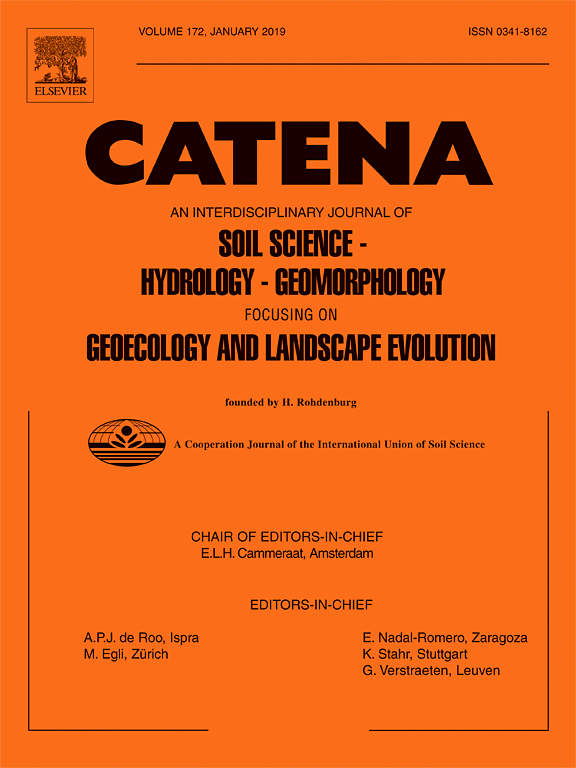Ver ítem
- xmlui.general.dspace_homeCentros Regionales y EEAsCentro Regional La Pampa - San LuisEEA AnguilArtículos científicosxmlui.ArtifactBrowser.ItemViewer.trail
- Inicio
- Centros Regionales y EEAs
- Centro Regional La Pampa - San Luis
- EEA Anguil
- Artículos científicos
- Ver ítem
Agricultural loess soils along a climosequence evidenced different susceptibility to acidification by simulated N-fertilization
Resumen
Agricultural loess soils of the central region of Argentina show acidification evidences linked to both climatic
conditions and N-fertilization. Because of that, simulations to estimate the future acidification trends under
continuing N-fertilization, considering the different neutralization capacities of the soils in this region, were
performed. An equivalent number of protons to that produced by a constant application of
180 kg urea ha−1 year−1 (84
[ver mas...]
Agricultural loess soils of the central region of Argentina show acidification evidences linked to both climatic
conditions and N-fertilization. Because of that, simulations to estimate the future acidification trends under
continuing N-fertilization, considering the different neutralization capacities of the soils in this region, were
performed. An equivalent number of protons to that produced by a constant application of
180 kg urea ha−1 year−1 (84 kg N ha−1 year−1) during 1, 10, 30 and 50 years of fertilization, was added to
unfertilized topsoil samples of agricultural Haplustolls, Hapludolls and Argiudolls. Mostly proton additions did
not modify neither CEC nor the contents of both amorphous and crystalline Al, Mn and Fe oxides. However, the
Hapludolls, located in the transition zone of the climosequence, showed decreases in their phyllosilicates
crystallinity with the most acidifying treatments equivalent to 30 and 50 years of N-fertilization. This effect was
less pronounced in those soils placed in both the driest (Haplustolls) and the moist (Argiudolls) environments,
due to the amount and composition of the substances and/or systems with acid neutralizing capacity that
prevailed. Thus, the Haplustolls were the less affected soils by acidification due to their high amount of free limeand
soil organic matter (SOM) as well as the smectitic mineralogy of their fine mineral fractions, clay and silt.
The Argiudolls were the soils with stronger neutralizing mechanisms given by both their high SOM and fine
mineral fractions contents, though illitic. Therefore, the Hapludolls were the most susceptible soils to being
acidified if N-fertilization continues, according to the low quantity of SOM and fine mineral fractions of illitic
mineralogy. From these results, the development and validation of mathematical models were assessed in order
to predict the soil buffer capacity and the future pH of the soils. The soil buffer capacity was explained 78% by
both the cation exchange and dissolution reactions of minerals accumulated in clays and silts, while pH values
were explained 75% by the cation exchange capacity as well as by the SOM, free-lime and clay and silt contents.
The pH that the soils would have in the future was predicted with an accuracy of 75% by the outcomes of the
simulations, and in a 57% by the pH values of no-tilled and urea fertilized soils.
[Cerrar]

Autor
Iturri, Laura Antonela;
Buschiazzo, Daniel Eduardo;
Fuente
CATENA 171 : 565-579. (December 2018)
Fecha
2018
Editorial
Elsevier
ISSN
0341-8162
Formato
pdf
Tipo de documento
artículo
Palabras Claves
Derechos de acceso
Restringido
 Excepto donde se diga explicitamente, este item se publica bajo la siguiente descripción: Creative Commons Attribution-NonCommercial-ShareAlike 2.5 Unported (CC BY-NC-SA 2.5)
Excepto donde se diga explicitamente, este item se publica bajo la siguiente descripción: Creative Commons Attribution-NonCommercial-ShareAlike 2.5 Unported (CC BY-NC-SA 2.5)

